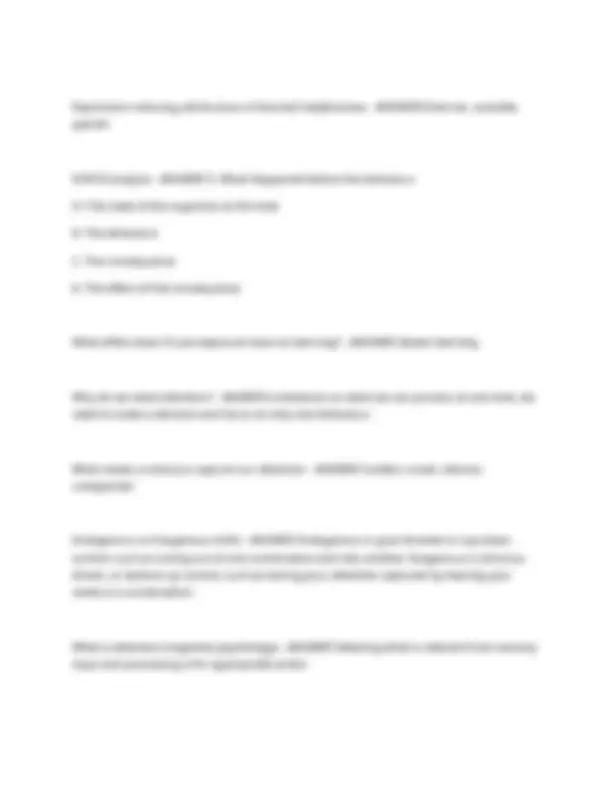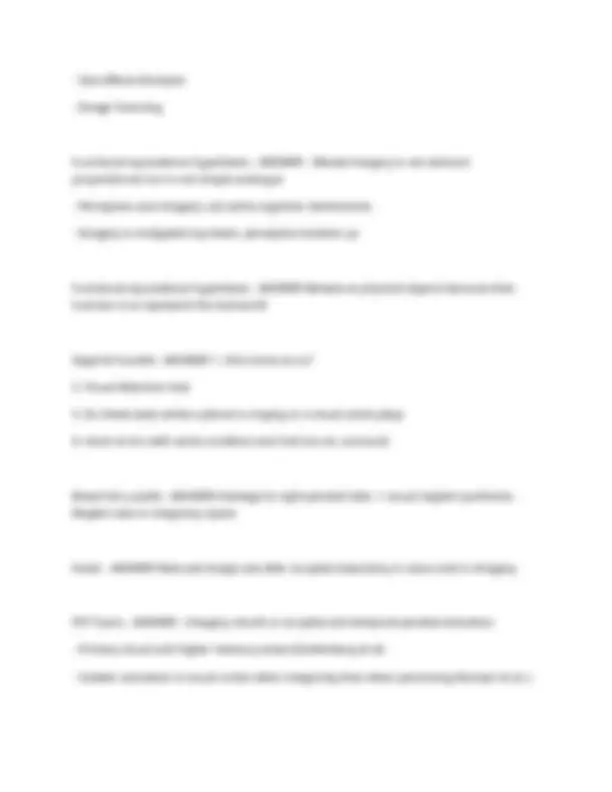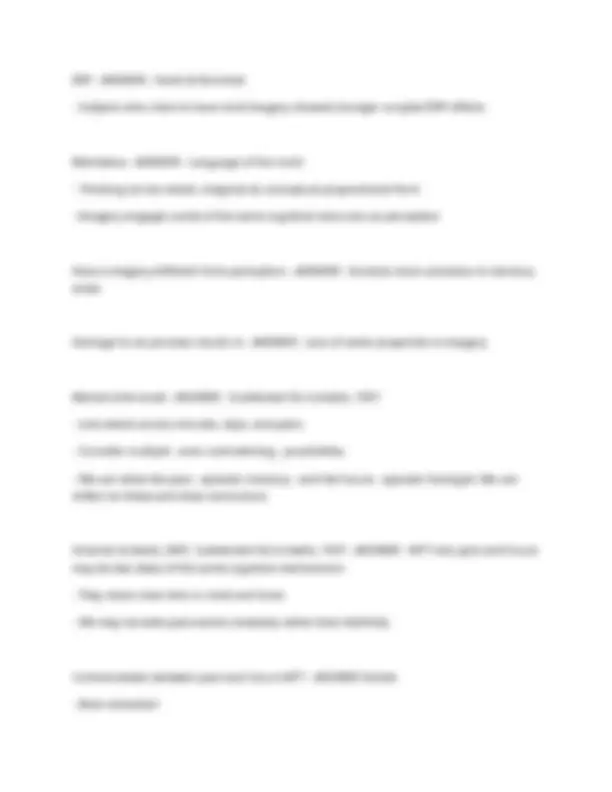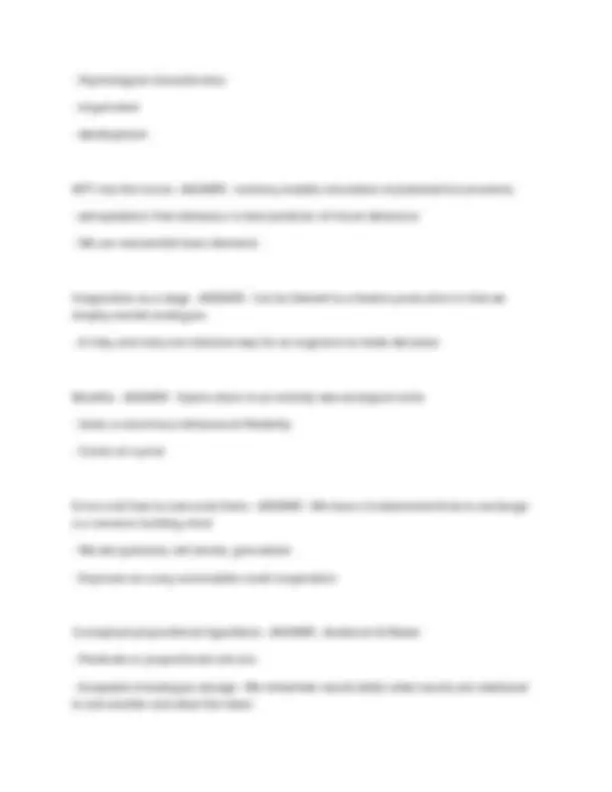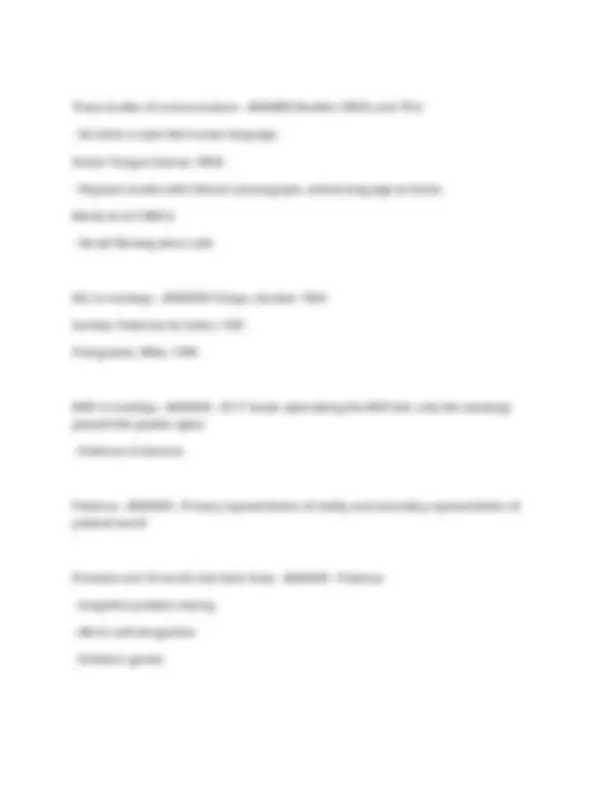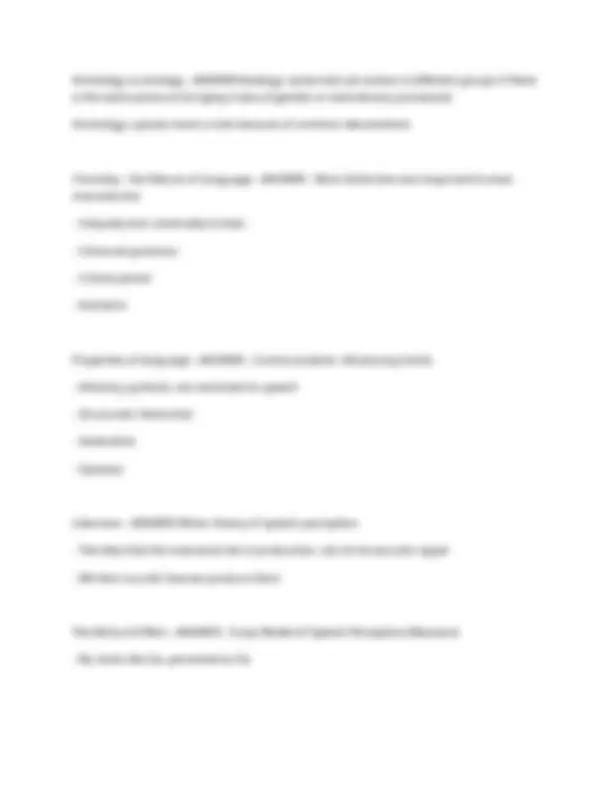Download PSYCH 2050 EXAM QUESTIONS AND VERIFIED ANSWERS. and more Exams Developmental Psychology in PDF only on Docsity!
PSYCH 2050 EXAM QUESTIONS AND VERIFIED
ANSWERS
Higher and lower level cognition - ANSWER Lower is closer to the input from our senses, high is further away, creates abstract cognition Habituation - ANSWER A "Getting used to it" response What does habituation teach us? - ANSWER Not every stimulus is significant and worthy of our attention Free energy Principle - ANSWER - Global theory about how the brain works
- Particular behaviours match particular outcomes
- Biological systems must maintain their states and minimise surprise 3 stages of classical conditioning - ANSWER Habituation (CS) Acquisition (CS+US) Extinction (CS) 2 factors influencing the acquisition curve - ANSWER 1. Intensity of the US
- Order and timing Delay short conditioning vs delay long conditioning - ANSWER Longer exposure to the CS alone Trace conditioning - ANSWER A gap between presentation of CS and US simultaneous conditioning - ANSWER CS and US are presented at the same time Backward Conditioning - ANSWER US is presented before CS Temporal conditioning - ANSWER the US is presented as set time intervals, thus time is the CS Two types of pavlovian conditioning - ANSWER Excitatory (CS predicts US) Inhibitory (CS predicts absence of US)
Retardation test - ANSWER 1. Inhibitory conditioning
- I + US and N+US Summation test - ANSWER 1. Inhibitory conditioning
- Present the excitatory with the inhibitor How to tell retardation and summation tests apart? - ANSWER Summation tests has the N presented alone What is Blocking? - ANSWER Kamin 1969
- When the CS is presented alongside an UCS and still presents the same result (light + bell = zap, light still = zap) What is super conditioning? - ANSWER - When the UCS predicts the absence of the CS (bell = zap, light + bell = no zap)
- Faster learning Rescorla-Wagner Model - ANSWER The strength of the CS-US association is determined by the extent to which the unconditioned stimulus is unexpected What is the Garcia effect? - ANSWER Equipotentiality does not hold The Law of Effect - ANSWER Tendency to perform an act is increased if rewarded, weakened if not What is shaping - ANSWER Guiding behavior toward closer and closer approximations of the desired behavior What is Baiting? - ANSWER Using a reinforcer to train a behaviour until it can be performed without it What is mimicking? - ANSWER Repeating behaviours What is chaining? - ANSWER Learning a behaviour in small pieces, often helps to start with he last behaviour What is bridging? - ANSWER Using a quick reinforcer to signal the arrival of an eventual reward
Premack's principle - ANSWER A high probability behaviour can reinforce a low probability behaviour Avoidance vs escape - ANSWER Prevent the occurrence of vs terminate an aversive consequence Learned helplessness - ANSWER Yoked experiment - Ps began to behave as if their behaviour had no effect on what happens to them What are some side effects of learned helplessness? - ANSWER - Depression
- Impaired learning
- Reduced activity
- Reduced immune response
- More stress related conditions (ulcers) How to combat learned helplessness? - ANSWER Place P in a condition where they cannot fail, give back some control Attributions of learned helplessness - ANSWER - Internal (because of me), external (not because of me)
- Stable (a trait I have), unstable (a one off accident)
- Global (applies to all contexts), specific (just this context) Depression promoting attributions of learned helplessness - ANSWER Internal, stable, global
Depression reducing attributions of learned helplessness - ANSWER External, unstable, specific SORCK analysis - ANSWER S: What Happened before the behaviour O: The state of the organism at the time R: The behaviour C: The consequence K: The effect of the consequence What effect does CS pre-exposure have on learning? - ANSWER Slower learning Why do we need attention? - ANSWER Limitations on what we can process at one time, we need to make a decision and focus on only one behaviour. What makes a stimulus capture our attention - ANSWER Sudden, onset, intense, unexpected Endogenous vs Exogenous shifts - ANSWER Endogenous is goal directed or top-down control, such as tuning out of one conversation and into another. Exogenous is stimulus- driven, or bottom-up control, such as having your attention captured by hearing your name in a conversation What is attention (cognitive psychology) - ANSWER Selecting what is relevant from sensory input and processing it for appropriate action
If a stimulus has one distinctive feature, what type of search is used? - ANSWER Parallel (feature) search Which type of search is slower and affected by set size? - ANSWER Conjunctive (serial) If i use my peripheral vision to search for my keys, what type of attention am I using? - ANSWER Covert What are the key functions of attention? - ANSWER Selective, shifting, dividing Broadbent's filter theory - ANSWER - Early selection
- Structural model What does RSVP stand for? - ANSWER Rapid Serial Visual Presentation When is task switching hardest? - ANSWER From a difficult task to an easy task, as its harder to disengage from a harder task What can eliminate switch costs? - ANSWER Nothing - there is no (know) way to eliminate them The three task switching theories - ANSWER - Disengagement theory (Allport et al., 1994)
- Endogenous + exogenous factors (Roger and Monsell)
- Endogenous only (De Jong, 2000)
Automatic processes - ANSWER are fast, rigid / habitual, happen without awareness, use little (mental) resources What are (for most people) automatic processes? - ANSWER Reading, eating, walking, feature search What is the limit for working memory? - ANSWER ~7 seconds if not refreshed (Miller 1956) or ~4 (Cowen 2000) Baddeley's WM model - ANSWER - Central executive
- Phonological loop
- Visuo-spatial sketchpad
- Episodic buffer The central executive - ANSWER Attention controller, interface between WM and LTM
- Does not have its own storage capacity The Phonological loop - ANSWER Maintains verbal, sequential information in sound-based code
- Verbal store (inner ear) Subvocal articulatory rehearsal process (inner voice) 4 key effects of phonological loop - ANSWER Phonological similarity effect, unattended speech effect, word length effect, concurrent articulation effect
In Jenkins & Dallenbach, which group had the largest rate of memory decay? - ANSWER Awake According to the Proactive class of interference effects - ANSWER Old information blocks new information Common types of recall tests? - ANSWER Free recall, serial recall, cued recall Elaborative processing is associated with ... - ANSWER Organisation, enhanced memory, promotes connections Levels of Processing model - ANSWER Ps can attend to three aspects, orthography (spelling), phonology (pronunciation), meaning (semantics) Connections vs distinctiveness - ANSWER Connections help support retrieval cues and paths, where distinctiveness helps discriminate among retrieved items Contextual cueing - ANSWER Incidental and implicit What is state dependent learning? - ANSWER Environmentally contextual learning What is TAP? - ANSWER Transfer is best when test processes overlap with processing at study For good memory... - ANSWER - Material should be encoded in a way that improves its accessibility at test
- Effective retrieval cues should be provided at test What is a flashbulb memory? - ANSWER A clear memory of an emotionally significant moment or event What is the word length effect? - ANSWER memory for lists of words is better for short words than for long words What is the unattended speech effect? - ANSWER Speech impairs serial verbal recall of visually presented material What is the phonological similarity effect? - ANSWER confusion of letters or words that sound similar What is the concurrent articulation effect? - ANSWER Saying something in head - Removes ability to rehearse info and impairs phonological processing of visual info Issues with Automaticity - ANSWER - Many processes don't meet criteria
- Some can be effected by task load Roger and Monsell theory - ANSWER - Exogenous + Endogenous
- Endogenous components require time -> switch cost reduced as prep time increases
- Residual costs can't be removed with prep time as exogenous component must be triggered by arrival of suitable stimulus Practice effects - ANSWER Costs are reduced but not eliminated with practice of task
- Size effects (Kosslyn)
- Image Scanning Functional equivalence hypothesis - ANSWER - Mental imagery is not abstract propositional, but is not simple analogue
- Perception and imagery use same cognitive mechanisms
- Imagery is instigated top down, perception bottom up Functional equivalence hypothesis - ANSWER Behave as physical objects because their function is to represent the real world Segal & Fuscella - ANSWER 1. Did a tone occur?
- Visual detection task
- Do these tasks while a phone is ringing or a visual scene plays
- more errors with same condition and trial (vis-vis, aud-aud) Bisiach & Luzzatti - ANSWER Damage to right parietal lobe -> visual neglect syndrome. Neglect also in imaginary space. Farah - ANSWER Reduced image size after occipital lobectomy in vision and in imagery PET Scans - ANSWER - Imagery results in occipital and temporal parietal activation
- Primary visual and higher memory areas (Goldenberg et al)
- Greater activation in visual cortex when imagining than when perceiving (Kosslyn et al.,)
ERP - ANSWER - Farah & Peronnet
- Subjects who claim to have vivid imagery showed stronger occipital ERP effects Mentalese - ANSWER - Language of the mind
- Thinking can be verbal, imaginal, & conceptual-propositional form
- Imagery engages some of the same cognitive resources as perception How is imagery different from perception - ANSWER - Involves more activation in memory areas Damage to visual areas results in - ANSWER - Loss of same properties in imagery Mental time travel - ANSWER - Suddendorf & Corballis, 1997
- Link events across minutes, days, and years
- Consider multiple - even contradicting - possibilities
- We can relive the past - episodic memory - and the future - episodic foresight. We can reflect on these and draw conclusions Schacter & Addis; 2007, Suddendorf & Corballis, 1997 - ANSWER - MTT into past and future may be two ideas of the same cognitive mechanisms
- They share close links in mind and brain
- We may recreate past events creatively rather than faithfully Commonalities between past and future MTT - ANSWER Similar
- Brain activation
Darwin's ape theory - ANSWER - Descended from Apes
- 99.4% DNA base pairs (Wildman et al., 2003) Emphasising dis/continuity - ANSWER Discontinuity:
- Justify personal / religious beliefs about human special status
- Justify human treatment of animals Continuity:
- Show Darwin was right and humans are a part of nature
- Show that the animal one is working with has a capacity What is the main difficulty when identifying absence of a mental state? - ANSWER Absence of evidence not evidence of absence. Baetson, 1991 - ANSWER If same neuronal equipment to detect damage, likely feels pain like us. Colpaert et al - ANSWER Rats prefer sugar water; rats with joint paint prefer water with analgesic Romanes - ANSWER Intelligence in animals
- Comparative psychology
- The use of anecdotes
The Principle of Parsimony - ANSWER - Lloyd Morgan's canon
- The Clever Hans Phenomenon Clever Hans phenomenon - ANSWER We may unknowingly give animals cues that will help them complete a required task. Clever Hans was a horse, that stomp until he was cued by an expression from the experimenter or audience because he learnt he got rewarded, conditioning not learning. Kohler 1917 - ANSWER Insight
- Use of tools to achieve goals
- Suggested that this could not be explained by stimulus response alone, required physical trial and error and insightful problem solving Boesch 1994 - ANSWER Chimps using tools in the wild that are produced in one place and used in another, such as toilet paper, hammer, anvil. The Machiavellian hypothesis of the evolution of intelligence. - ANSWER - Social intelligence as a prime mover
- The association between neocortex ratio and group size -Social mammals live longer (Zhu et al., 2023) Primate social intelligence - ANSWER - Group living
- Grooming
- Social heirarchies
- Keeping track of third party relations
- Tactical deceptions
Homology vs anology - ANSWER Analogy: same trait can evolve in different groups if there is the same pressure bringing it about (genetic or evolutionary processes) Homology: species share a trait because of common descendants Chomsky - the Nature of Language - ANSWER - Most distinctive and important human characteristic
- Uniquely and universally human
- Universal grammar
- Critical period
- Evolution Properties of language - ANSWER - Communicative: influencing minds
- Arbitrary symbols: not restricted to speech
- Structured: Hierarchal
- Generative
- Dynamic Liberman - ANSWER Motor theory of speech perception
- The idea that the invariance lies in production, not int he acoustic signal
- We hear sounds how we produce them The McGurk Effect - ANSWER - Fuzzy Model of Speech Perception (Massaro)
- Ba, looks like Ga, perceived as Da
What is a morpheme and what is morphology? - ANSWER smallest meaningful unit of meaning, not sound. Morphology is rules governing how their put together. What are functional morphemes? - ANSWER Inflections. Grammatical functions with little meaning by themselves, like -s, -ed, -ing. Syntax - ANSWER Rules by which words are structured into phrases and sentences. Little to do with meaning (semantics) Tail vs embedded recursion - ANSWER Tail recursion is at the end of the sentence, embedded is throughout in the same order, but different positions. Chomsky's Universal Grammar - ANSWER Languages differ in surface structure, underlying rules share many elements, and reflect innate organising principles of cognitions Maxim of Quantity - ANSWER Make contribution as informative as required, but no more informative than is appropriate Maxim of Quality - ANSWER Contribution should be truthful, you are expected to say what you believe Maxim of relation - ANSWER Contributions relevant to the aims of the conversation Maxim of Manner - ANSWER AVoid obscure expressions, vague utterances, and purposeful obfuscations of your point



